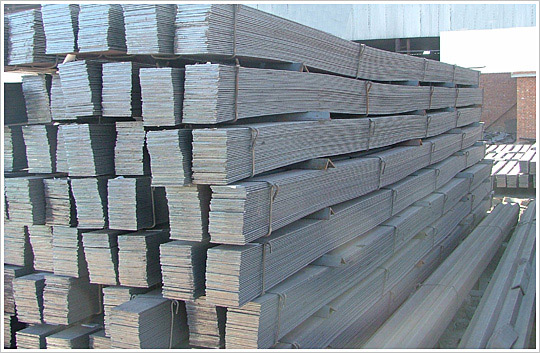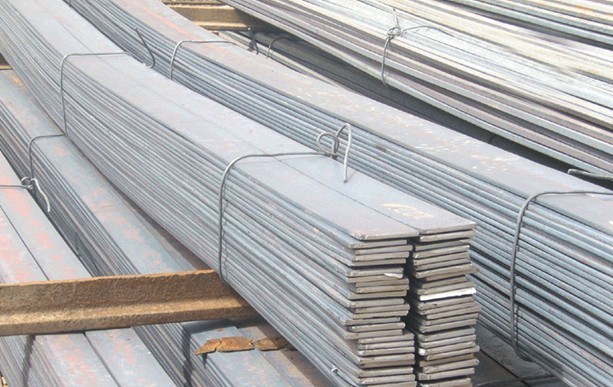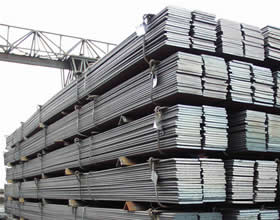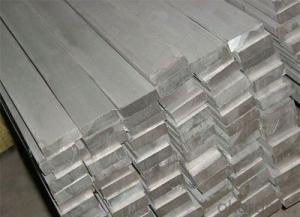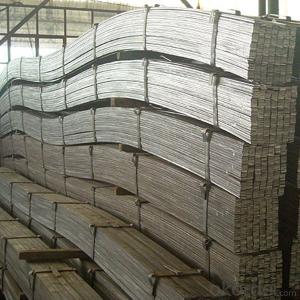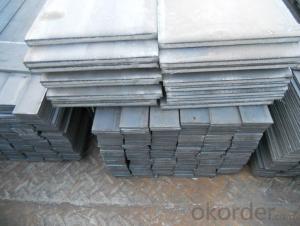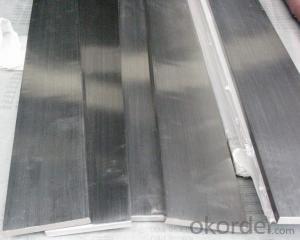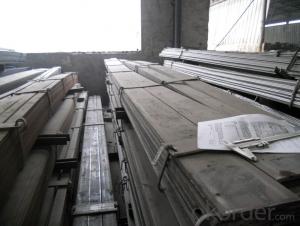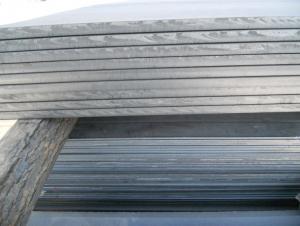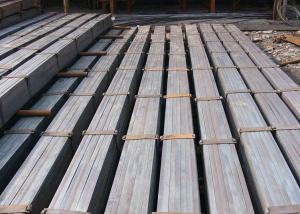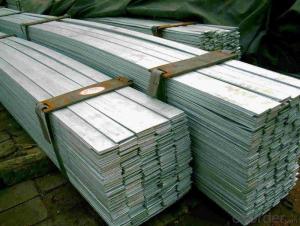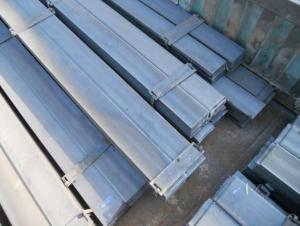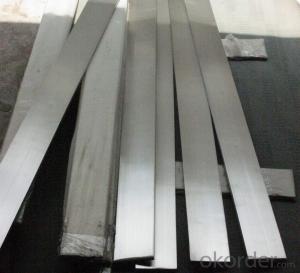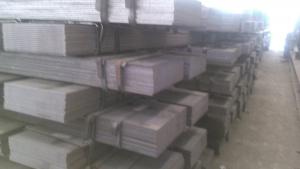Flat Steel Bar
- Loading Port:
- China Main Port
- Payment Terms:
- TT OR LC
- Min Order Qty:
- -
- Supply Capability:
- -
OKorder Service Pledge
OKorder Financial Service
You Might Also Like
Product Description:
Spring Steel can be divided into two types. One is carbon spring steel, and other one is alloy spring steel.
Alloy spring steel is based on carbon spring steel, by adding one or more alloying elements to improve the mechanical properties, hardenability and other properties to meet the requirement for manufacturing all kinds of spring steel.
Specification of Spring Steel:
-Material: 70Si2CrA
-Production: Hot rolled or cold rolled
-Standard: GB/T·5218-1999
-Type: Spring Steel
-Alloy or no: Alloy
Chemical Composition:
C | Mn | Si | Cr |
0.65~0.75 | 0.40~0.60 | 1.40~1.70 | 0.20~0.40 |
S | P | Ni | |
≤0.030 | ≤0.030 | ≤0.030 | |
Mechanical Properties:
-Annealing Condition:
1, Tensile Strength: σb/MPa:≤835
2, Elongation: δ/%:≥8
-Quencher condition:
1, Tensile strength: σb/MPa:785~1175
2, Elongation: -
Usage/Applications of Spring Steel:
For manufacturing all kinds of flat spring or round spring with small sections, clockwork spring,
Packaging & Delivery of Spring Steel:
-Packing Detail: The products can be packed in bundles by steel wires.
-Marks:
1, Tag marks: the tag marks will be tied up to each bundle of the products. The information is usually including supplier’s logo and name, product name, made in China, products’ specifications, the painted color and other information requested by customers.
2, Color marks: we will paint both ends of the bundles of these products to make sure that they are more evident. It’s will be more convenient for the customers to distinguish them at the destination port.
-Delivery Detail:
1, Delivery time: 30~45 working days after receive buyer’s T.T. or L/C.
2, Delivery status should be written in the contract. (Heat treatment or no)
Payment:
-Invoicing on theoretical weight or actual weight as customer’s request.
-FOB, CFR or CIF.
-Regular terms of payment:
1, 30% payment in advance, the remaining balance (70% payment) against the copy of B/L. 100% payment before shipment.
2, 30% payment in advance, the remaining balance (70% L/C) against the copy of B/L. 100% payment before shipment.
3, Negotiable.
- Q: What are the safety precautions when handling steel flat bars?
- To ensure the well-being of those involved, it is important to take several safety precautions when dealing with steel flat bars. 1. Personal Protective Equipment (PPE) is crucial and should be worn to minimize the risk of injuries. This includes gloves, safety glasses, and steel-toed boots, which protect against cuts, eye injuries, and foot injuries. 2. Proper lifting techniques should be used to avoid strain or back injuries. Lift with your legs, not your back, and seek assistance if the weight is too heavy to handle alone. 3. Securely store and stack steel flat bars to prevent them from falling or toppling over. Use appropriate storage racks or shelves to keep them organized and eliminate potential hazards. 4. Handle steel flat bars with care as they often have sharp edges. Avoid dragging or sliding them across surfaces to prevent injuries. Rounding or deburring the edges can also reduce the risk of cuts. 5. Maintain fire safety by keeping the work area clear of flammable materials and having fire extinguishers available. Avoid using steel flat bars near open flames or other sources of ignition. 6. Proper training is essential for safe handling. Educate yourself and others on the correct techniques and precautions to minimize potential risks. 7. Regularly inspect steel flat bars for damage, such as cracks or corrosion, and replace any damaged bars to prevent accidents. By implementing these safety precautions, individuals can effectively reduce the risks associated with handling steel flat bars and create a safer work environment.
- Q: Are steel flat bars suitable for outdoor signage or displays?
- Yes, steel flat bars are indeed suitable for outdoor signage or displays. Steel is a highly durable and weather-resistant material, making it ideal for withstanding the elements and ensuring long-lasting performance in outdoor environments. The flat bar shape provides a sturdy and stable foundation for hanging or mounting various types of signage or displays. Additionally, steel can be easily customized and manipulated to fit specific design requirements, allowing for endless creative possibilities in outdoor advertising and branding. Overall, steel flat bars are a reliable and versatile choice for outdoor signage or displays, ensuring durability, strength, and visual impact.
- Q: What are the different types of surface finishes for titanium steel flat bars?
- The different types of surface finishes for titanium steel flat bars include mill finish, brushed finish, polished finish, and coated finish.
- Q: What are the different types of surface treatments available for steel flat bars?
- Steel flat bars have a variety of surface treatments available, each with its own unique benefits and characteristics. Some commonly used treatments include: 1. Hot-dip galvanizing: By immersing the steel flat bar in molten zinc, a protective layer is formed to prevent rust and corrosion. This treatment offers excellent durability and resistance to atmospheric conditions. 2. Powder coating: This method involves applying a powdered polymer coating to the surface of the steel flat bar. The powder is charged with electricity and then cured under heat, resulting in a tough and durable finish. Powder coating provides excellent resistance to impact, chemicals, and abrasion, and offers a wide range of colors and finishes. 3. Electroplating: Electroplating deposits a thin layer of metal onto the steel flat bar through an electrochemical process. The choice of metal, such as chromium, nickel, or zinc, depends on the desired properties. Electroplating enhances the appearance, corrosion resistance, and wear resistance of the steel. 4. Paint coating: Applying a paint coating to the steel flat bar is a commonly used surface treatment. This can be done through methods like spray painting or roller coating. Paint coatings not only provide a decorative finish but also protect against corrosion and environmental factors. 5. Anodizing: Although primarily used for aluminum, anodizing can also be applied to steel. This process involves creating a controlled oxidization layer on the metal's surface, enhancing corrosion resistance and providing an attractive finish. Anodizing can be done in various colors and offers excellent durability. 6. Phosphating: Phosphating treats the steel flat bar with a phosphate coating, typically by immersing it in a solution containing phosphoric acid and other chemicals. This creates a thin, crystalline layer that improves corrosion resistance and enhances the adhesion of subsequent coatings or paints. These examples represent just a few of the surface treatments available for steel flat bars. The choice of treatment depends on factors such as desired appearance, environmental conditions, and specific functional requirements.
- Q: How do steel flat bars perform in corrosive or acidic environments?
- Steel flat bars can be susceptible to corrosion in corrosive or acidic environments. The extent of their performance would depend on the type of steel used and any additional protective coatings applied. However, in general, steel flat bars may require regular maintenance and protective measures to prevent or minimize corrosion in such environments.
- Q: What are the different types of surface finishes for brass steel flat bars?
- Some common types of surface finishes for brass steel flat bars include polished, brushed, satin, antique, and patina finishes.
- Q: What are the different methods of surface polishing for steel flat bars?
- There are several different methods of surface polishing for steel flat bars, each with its own advantages and applications. 1. Grinding: Grinding is a common method used to polish steel surfaces. It involves using an abrasive wheel or belt to remove material from the surface in order to achieve the desired finish. Grinding is typically used for rough polishing or to remove surface imperfections. 2. Buffing: Buffing is a polishing technique that involves using a soft cloth wheel or pad along with a polishing compound to smooth and shine the surface of the steel. Buffing is often used to achieve a high-gloss finish and is commonly employed in industries such as automotive or jewelry manufacturing. 3. Sanding: Sanding is a method of surface polishing that involves using abrasive sandpaper or sanding belts to smooth the steel surface. It is particularly effective for removing scratches or blemishes and can be done by hand or with the aid of power tools. 4. Electropolishing: Electropolishing is an electrochemical process that uses an electric current and an electrolyte solution to remove surface material and create a smooth, polished finish. It is commonly used for stainless steel flat bars and provides a high level of cleanliness and corrosion resistance. 5. Vibratory Polishing: Vibratory polishing utilizes a vibratory tumbler or bowl filled with abrasive media to polish the steel flat bars. The continuous motion of the media against the surface helps to remove burrs, smooth edges, and achieve a consistent finish. This method is often used for mass production or to polish small or intricate parts. 6. Chemical Polishing: Chemical polishing involves using a chemical solution to dissolve a thin layer of the steel surface, resulting in a smooth and polished finish. This method is often used for complex shapes or delicate parts where mechanical polishing may be difficult or impractical. It is important to note that the specific method of surface polishing chosen for steel flat bars will depend on factors such as the desired finish, the level of surface imperfections, the material composition, and the intended application of the bars.
- Q: Can steel flat bars be galvanized or coated with zinc?
- Yes, steel flat bars can be galvanized or coated with zinc. This process helps to protect the steel from corrosion and rust, extending its lifespan and enhancing its durability.
- Q: How do steel flat bars compare to other types of metal flat bars?
- Steel flat bars have several advantages over other types of metal flat bars. Firstly, steel is known for its strength and durability, making it a reliable choice for various applications. Steel flat bars can withstand heavy loads and are less likely to bend or break under pressure compared to other metals. Additionally, steel flat bars offer excellent corrosion resistance, especially when compared to metals like aluminum or copper. This makes them suitable for outdoor or marine environments where exposure to moisture or saltwater is common. Another advantage of steel flat bars is their versatility. They can be easily welded, formed, or machined to meet specific requirements. Steel can also be heat-treated to enhance its properties, such as hardness or toughness. Furthermore, steel flat bars are readily available in a wide range of sizes and thicknesses, making them suitable for various construction, manufacturing, and industrial applications. They are commonly used in structural support, frames, brackets, and machinery components. However, it is important to note that steel flat bars may be heavier than other metals, such as aluminum. This can be a consideration when weight is a concern, especially in industries like aerospace or automotive. Overall, steel flat bars offer a combination of strength, durability, corrosion resistance, and versatility that makes them a popular choice in many industries.
- Q: Are steel flat bars suitable for earthquake-resistant structures?
- Steel flat bars can be suitable for earthquake-resistant structures due to their high strength and ductility. They can effectively absorb and distribute seismic forces, enhancing the structural stability and reducing the risk of collapse during an earthquake. However, the overall suitability of steel flat bars depends on various factors such as design, construction techniques, and adherence to building codes and regulations. It is crucial to consult with structural engineers and follow proper engineering practices to ensure the effectiveness of steel flat bars in earthquake-resistant structures.
Send your message to us
Flat Steel Bar
- Loading Port:
- China Main Port
- Payment Terms:
- TT OR LC
- Min Order Qty:
- -
- Supply Capability:
- -
OKorder Service Pledge
OKorder Financial Service
Similar products
Hot products
Hot Searches
Related keywords




